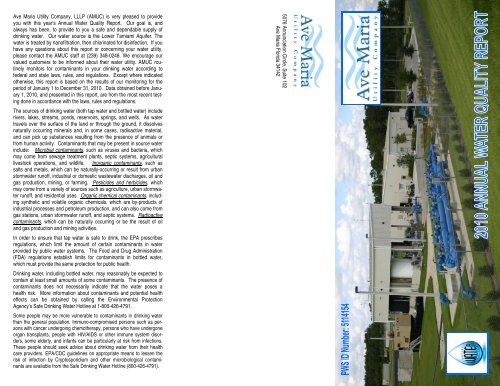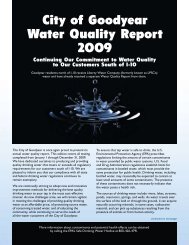Ave Maria, FL Water Report
Ave Maria, FL Water Report
Ave Maria, FL Water Report
Create successful ePaper yourself
Turn your PDF publications into a flip-book with our unique Google optimized e-Paper software.
<strong>Ave</strong> <strong>Maria</strong> Utility Company, LLLP (AMUC) is very pleased to provide<br />
you with this year’s Annual <strong>Water</strong> Quality <strong>Report</strong>. Our goal is, and<br />
always has been, to provide to you a safe and dependable supply of<br />
drinking water. Our water source is the Lower Tamiami Aquifer. The<br />
water is treated by nanofiltration, then chlorinated for disinfection. If you<br />
have any questions about this report or concerning your water utility,<br />
please contact the AMUC staff at (239) 348-0248. We encourage our<br />
valued customers to be informed about their water utility. AMUC routinely<br />
monitors for contaminants in your drinking water according to<br />
federal and state laws, rules, and regulations. Except where indicated<br />
otherwise, this report is based on the results of our monitoring for the<br />
period of January 1 to December 31, 2010. Data obtained before January<br />
1, 2010, and presented in this report, are from the most recent testing<br />
done in accordance with the laws, rules and regulations.<br />
The sources of drinking water (both tap water and bottled water) include<br />
rivers, lakes, streams, ponds, reservoirs, springs, and wells. As water<br />
travels over the surface of the land or through the ground, it dissolves<br />
naturally occurring minerals and, in some cases, radioactive material,<br />
and can pick up substances resulting from the presence of animals or<br />
from human activity. Contaminants that may be present in source water<br />
include: Microbial contaminants, such as viruses and bacteria, which<br />
may come from sewage treatment plants, septic systems, agricultural<br />
livestock operations, and wildlife. Inorganic contaminants, such as<br />
salts and metals, which can be naturally-occurring or result from urban<br />
stormwater runoff, industrial or domestic wastewater discharges, oil and<br />
gas production, mining, or farming. Pesticides and herbicides, which<br />
may come from a variety of sources such as agriculture, urban stormwater<br />
runoff, and residential uses. Organic chemical contaminants, including<br />
synthetic and volatile organic chemicals, which are by-products of<br />
industrial processes and petroleum production, and can also come from<br />
gas stations, urban stormwater runoff, and septic systems. Radioactive<br />
contaminants, which can be naturally occurring or be the result of oil<br />
and gas production and mining activities.<br />
In order to ensure that tap water is safe to drink, the EPA prescribes<br />
regulations, which limit the amount of certain contaminants in water<br />
provided by public water systems. The Food and Drug Administration<br />
(FDA) regulations establish limits for contaminants in bottled water,<br />
which must provide the same protection for public health.<br />
Drinking water, including bottled water, may reasonably be expected to<br />
contain at least small amounts of some contaminants. The presence of<br />
contaminants does not necessarily indicate that the water poses a<br />
health risk. More information about contaminants and potential health<br />
effects can be obtained by calling the Environmental Protection<br />
Agency’s Safe Drinking <strong>Water</strong> Hotline at 1-800-426-4791.<br />
Some people may be more vulnerable to contaminants in drinking water<br />
than the general population. Immuno-compromised persons such as persons<br />
with cancer undergoing chemotherapy, persons who have undergone<br />
organ transplants, people with HIV/AIDS or other immune system disorders,<br />
some elderly, and infants can be particularly at risk from infections.<br />
These people should seek advice about drinking water from their health<br />
care providers. EPA/CDC guidelines on appropriate means to lessen the<br />
risk of infection by Cryptosporidium and other microbiological contaminants<br />
are available from the Safe Drinking <strong>Water</strong> Hotline (800-426-4791).<br />
5076 Annunciation Circle, Suite 102<br />
<strong>Ave</strong> <strong>Maria</strong> Florida 34142
Radiological Contaminants<br />
Contaminant and Unit of<br />
Measurement<br />
Radium 226 or combined radium<br />
(pCi/l)<br />
Inorganic Contaminants<br />
Contaminant and Unit of<br />
Measurement<br />
<strong>Ave</strong> <strong>Maria</strong> Utility Company, LLLP 2010 Monitoring Results for Contaminants in Drinking <strong>Water</strong><br />
Dates of sampling (mo./yr.)<br />
MCL Violation<br />
Y/N<br />
Level Detected Range of Results MCLG MCL Likely Source of Contamination<br />
Quarterly 2007 No 0.25 0 - 1.0 0 5 Erosion of natural deposits<br />
Dates of sampling (mo./yr.)<br />
MCL Violation<br />
Y/N<br />
Level Detected MCLG MCL Likely Source of Contamination<br />
Barium (ppm) 12/09 No 0.0056 2 2 Discharge of drilling wastes; discharge from metal refineries;<br />
erosion of natural deposits<br />
Nitrate (as Nitrogen) (ppm) 03/10 No 0.03 10 10 Runoff from fertilizer use; leaching from septic tanks,<br />
sewage; erosion of natural deposits<br />
Nitrite (as Nitrogen) (ppm) 03/10 No 0.02 1 1 Runoff from fertilizer use; leaching from septic tanks,<br />
sewage; erosion of natural deposits<br />
Sodium (ppm) 12/09 No 19 NA 160 Salt water intrusion; leaching from soil<br />
Chromium (ppb) 12/09 No 0.6 100 100 Discharge from steel and pulp mills; erosion of natural<br />
deposits<br />
Nickel (ppb) 12/09 No 1.1 NA 100 Pollution from mining and refining operations; natural<br />
occurrence in soils<br />
Stage 1 Disinfectant/Disinfection By-Product (D/DBP) Contaminants<br />
Contaminant and Unit of<br />
Dates of sampling (mo./yr.) MCL Violation Level Detected 1 Range of Results MCLG or MRDLG MCL or MRDL Likely Source of Contamination<br />
Measurement<br />
Y/N<br />
Chlorine (ppm) Monthly 2010 No 2.13 1.5 - 3.0 MRDLG = 4 MRDL = 4 <strong>Water</strong> additive used to control microbes<br />
Haloacetic Acids (five) (HAA5) (ppb) 09/09 No 9.7 NA NA MCL = 60 By-product of drinking water disinfection<br />
TTHM (ppb) [Total Trihalomethanes}<br />
Lead and Copper (Tap <strong>Water</strong>)<br />
Contaminant and Unit of<br />
Measurement<br />
09/09 No 21.4 NA NA MCL = 80 By-product of drinking water disinfection<br />
Dates of sampling (mo./yr.)<br />
AL Violation<br />
Y/N<br />
90th Percentile Result No. of sampling sites<br />
exceeding the AL<br />
MCLG AL (Action Level) Likely Source of Contamination<br />
Copper (tap water) (ppm) 09/09 No 0.47 0 1.3 1.3 Corrosion of household plumbing systems; erosion of<br />
natural deposits; leaching from wood preservatives<br />
Lead (tap water) (ppm) 09/09 No 1.3 0 0 15 Corrosion of household plumbing systems; erosion of<br />
natural deposits<br />
Notes:<br />
1 The result in the level detected column for TTHMs is the highest of the four quarterly running annual averages of results from all sampling<br />
sites.<br />
Definitions:<br />
Maximum Contaminant Level or MCL: The highest level of a contaminant that is allowed in drinking water. MCLs are set as close to<br />
the MCLGs as feasible using the best available treatment technology.<br />
Maximum Contaminant Level Goal or MCLG: The level of a contaminant in drinking water below which there is no known or expected<br />
risk to health. MCLGs allow for a margin of safety.<br />
Action Level (AL): The concentration of a contaminant that, if exceeded, triggers treatment or other requirements that a water system<br />
must follow.<br />
Maximum residual disinfectant level or MRDL: The highest level of a disinfectant allowed in drinking water. There is convincing<br />
evidence that addition of a disinfectant is necessary for control of microbial contaminants.<br />
Maximum residual disinfectant level goal or MRDLG: The level of a drinking water disinfectant below which there<br />
is no known or expected risk to health. MRDLGs to not reflect the benefits of the use of disinfectants to control microbial contaminants.<br />
ND: means not detected and indicates that the substance was not found by laboratory analysis.<br />
Parts per million (ppm) or Milligrams per liter (mg/l): one part by weight of analyte to 1 million parts by weight of the water sample.<br />
Parts per billion (ppb) or Micrograms per liter (µg/l): one part by weight of analyte to 1 billion parts by weight of the<br />
water sample.<br />
Picocurie per liter (pCi/L): measure of the radioactivity in water.<br />
Source <strong>Water</strong> Assessment:<br />
In 2009, a source water assessment was conducted for our water system. The assessment found one potential<br />
source of contamination near the wells; a petroleum storage tank. The hazard level is considered to be moderate.<br />
Source water assessments are posted at http://www.dep.state.fl.us/swapp/.<br />
Lead:<br />
If present, elevated levels of lead can cause serious health problems, especially for pregnant women and young<br />
children. Lead in drinking water is primarily from materials and components associated with service lines and home<br />
plumbing. <strong>Ave</strong> <strong>Maria</strong> Utility Company, LLLP is responsible for providing high quality drinking water, but cannot control<br />
the variety of materials used in plumbing components. When your water has been sitting for several hours, you can<br />
minimize the potential for lead exposure by flushing your tap for 30 seconds to 2 minutes before drinking or cooking.<br />
If you are concerned about lead in your water, you may wish to have your water tested. Information on lead in drinking<br />
water, testing methods, and steps you can take to minimize exposure is available from the Safe Drinking <strong>Water</strong><br />
Hotline (1-800-426-4791) or at http://www.epa.gov/safewater/lead.



